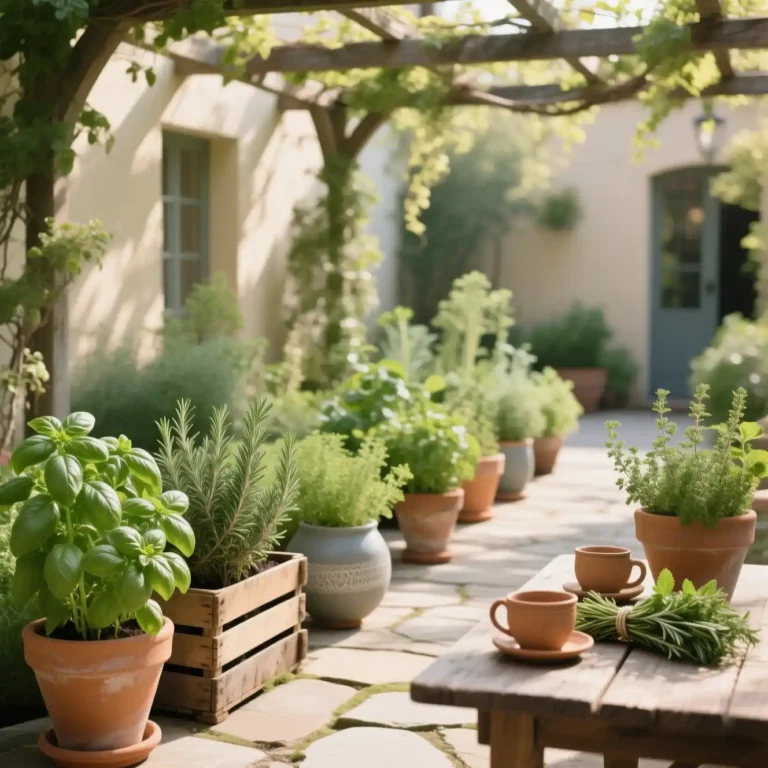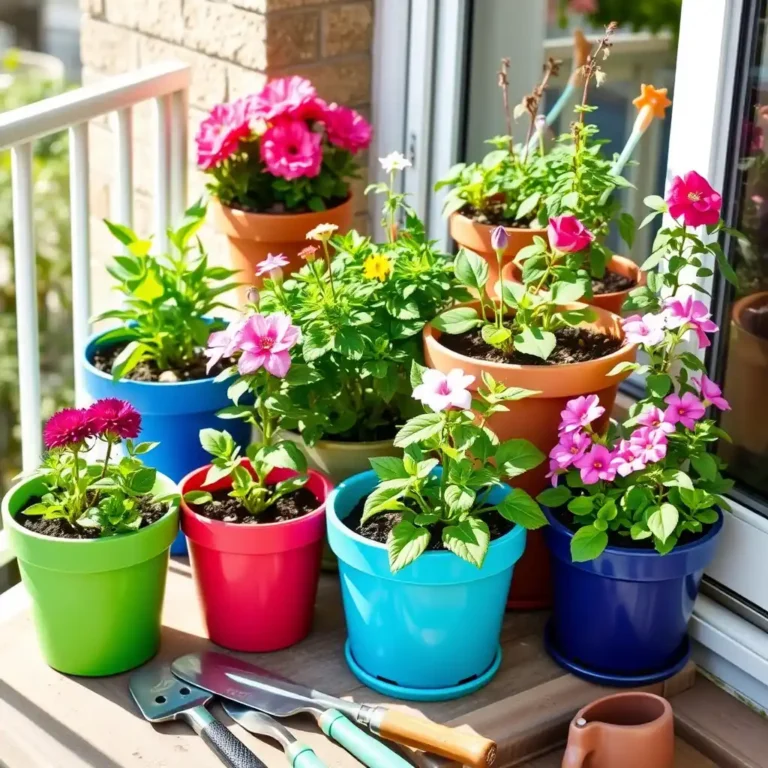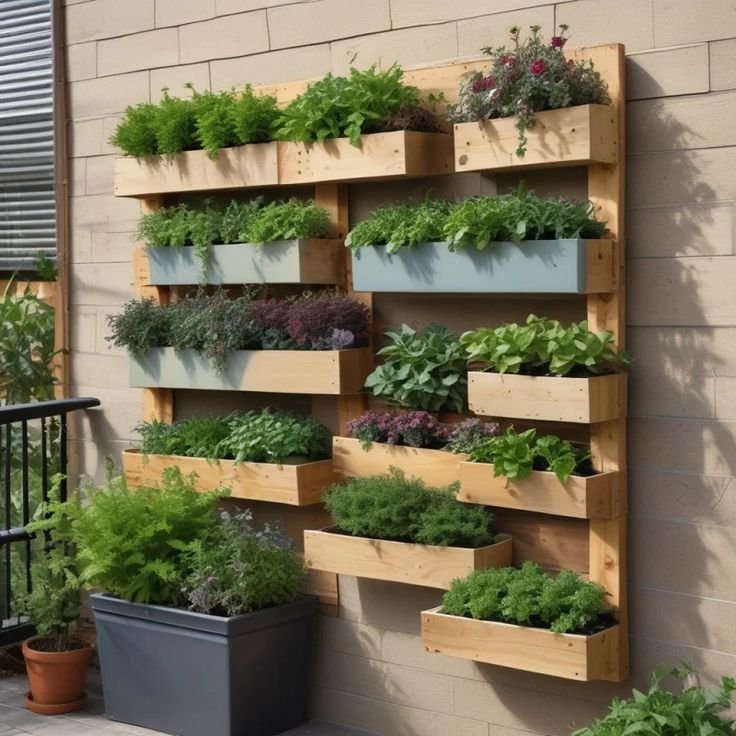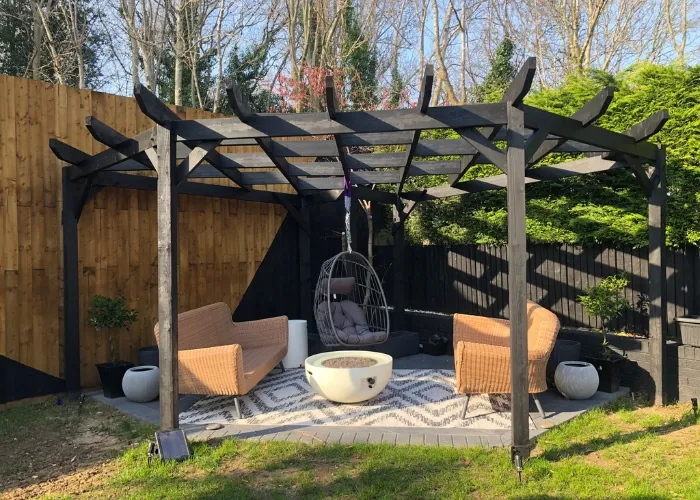15 Eco-Friendly Mulch Landscaping Ideas for a Sustainable Front Yard!
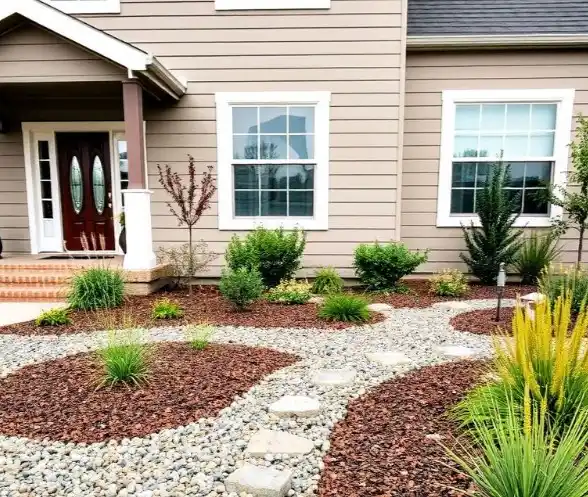
Welcome to a world where your front yard can be both beautiful and sustainable!
Incorporating eco-friendly mulch landscaping into your garden not only enhances its aesthetic appeal but also promotes environmental health.
From organic materials to creative designs, this article explores 15 captivating ideas that will inspire you to transform your outdoor space into a green oasis.
Insider Tips for Eco-Friendly Mulch Landscaping
Imagine a front yard that’s a stunning, sustainable showcase, where eco-friendly mulch and native plants create a low-maintenance, vibrant oasis that supports the planet while boosting curb appeal. These budget-friendly ideas will transform your front yard, perfect for welcoming guests or crafting a green, gorgeous entrance.
- Native Plant Mulch Beds: Use shredded bark or leaf mulch around native wildflowers like black-eyed Susans or coneflowers to retain moisture and suppress weeds. It’s like your yard’s nurturing a local ecosystem with earthy charm.
- Rubber-Free Rubber Mulch Alternative: Opt for pine straw or cedar mulch for a natural, aromatic ground cover that’s chemical-free and insect-repellent. It feels like your front yard’s wrapped in a sustainable, fragrant embrace.
- Compost Mulch Pathway: Spread homemade compost as mulch along a stone path, enriched with kitchen scraps for nutrient-rich soil. It’s like your yard’s recycling waste into a blooming welcome mat.
- Living Mulch Groundcover: Plant creeping thyme or clover as a living mulch to reduce erosion and water needs while adding green beauty. It’s like your front yard’s growing its own eco-friendly carpet.
- Recycled Wood Chip Beds: Use free wood chips from local tree services as mulch for shrubs or perennials, turning waste into a rustic, sustainable look. It feels like your yard’s upcycling nature’s bounty.
- Straw Bale Edging: Arrange straw bales as mulch borders for raised beds, adding texture and compost value over time. It’s like your front yard’s channeling a cozy, harvest-inspired vibe.
- Seaweed or Kelp Mulch: Apply dried seaweed mulch for coastal-inspired gardens, providing natural nutrients and ocean-fresh appeal. It’s like your yard’s whispering seaside sustainability.
Let’s dive into these sustainable landscaping trends that will make your front yard the talk of the neighborhood while being kind to the planet!
Natural Stone Pathways

Image Credit: gunn1971
Creating a winding pathway with natural stones surrounded by rich, organic mulch is a stunning way to enhance your front yard.
The combination of stones and mulch not only looks great but also serves practical purposes, such as preventing weed growth and aiding water retention in the soil. Stones can be arranged in various patterns, allowing for personalized creativity and uniqueness.
– Tip: Choose stones that complement your home’s architecture.
– Insight: Natural stone pathways can be made even more interesting by adding small flowering plants in between stones for a pop of color.
– Sustainability Note: Using locally sourced stones reduces your carbon footprint and supports local businesses.
This natural aesthetic invites visitors to stroll through your garden while providing essential benefits to the ecosystem.
Dark Mulch with Bright Flowers

Image Credit: toomuchtimehome
Dark mulch provides a striking contrast against vibrant flower beds, making your garden pop!
The deep tones of the mulch can help absorb heat, benefiting your plants while giving your yard a polished look. This method is especially effective in areas with colorful blooms like daisies or marigolds.
– Tip: Use a mix of perennials and annuals to ensure year-round color.
– Insight: Dark mulch can also help retain moisture and regulate soil temperature, promoting healthy plant growth.
– Unique Element: Consider incorporating decorative stones or garden ornaments among the flowers for added visual interest.
This vibrant combination not only beautifies your space but also fosters an inviting environment for pollinators.
Layered Rock and Mulch Gardens

Image Credit: kathrynawilson
Layering rocks with mulch creates a dynamic texture in your landscaping.
This method adds depth while also providing excellent drainage for your plants. You can use larger stones as a border, with smaller pebbles or gravel to create paths, and organic mulch to fill in the gaps.
– Tip: Choose rocks that are native to your area for an eco-friendly approach.
– Suggestion: Incorporate drought-resistant plants to thrive in this type of landscape.
– Issue to Consider: Ensure the rocks are not too sharp to avoid injuries during maintenance.
This design is visually appealing and reduces the need for excessive watering, making it a sustainable choice.
White Pebble Accents

Image Credit: lanyainthehouse
White pebbles create a stunning contrast when combined with black mulch in your garden.
This chic approach adds sophistication and elegance while drawing attention to your plant life. The white pebbles can be used as a pathway or as a border around flower beds.
– Tip: Mix in some colored stones to break up the monotony and add character.
– Unique Insight: White stones reflect sunlight, which can help to keep the surrounding area cooler in hot climates.
– Maintenance Note: Regularly check for weeds, as they can become more visible against the light backdrop.
This modern touch not only beautifies your space but also encourages efficient water drainage.
Mulch and Paver Combination

Image Credit: kumrucan
Combining pavers with mulch creates a well-defined pathway that enhances the structure of your garden.
This design invites visitors into your space while offering functional benefits like weed suppression and soil moisture retention. Pavers can be arranged in various patterns, providing a unique flair to your landscaping.
– Tip: Use permeable pavers to allow water to flow through and avoid runoff.
– Insight: Mulch type can affect the overall aesthetic; try using different colors to match your home’s exterior.
– Sustainability Note: This combination promotes drainage and helps prevent erosion in sloped yards.
Create a welcoming environment with this classy yet practical approach!
Rustic Log Edges

Image Credit: laydebug66
Incorporating rustic log edges around your mulch beds adds a natural, organic touch to your landscaping.
This design not only looks charming but also helps keep mulch contained, reducing the need for frequent replenishment. Using logs creates a natural barrier that integrates seamlessly with the garden environment.
– Tip: Choose logs that are untreated to avoid chemical leaching into the soil.
– Insight: Log edges can attract beneficial insects and provide habitats for small critters.
– Unique Element: Add small plants or flowers directly into the log spaces for a whimsical effect.
This approach enhances the beauty of your front yard while promoting biodiversity.
Colorful Flower Borders

Image Credit: vbrosch
Bright flowers surrounded by a thick layer of mulch create a vibrant and inviting space.
This method not only enhances visual appeal but also provides essential nutrients to the soil as the mulch decomposes. Using a variety of flower types can ensure continuous blooms throughout the seasons.
– Suggestion: Incorporate native plants to attract local pollinators.
– Tip: Use organic mulch to enrich the soil naturally over time.
– Unique Insight: Planting in layers can create depth, making your garden look fuller and more lush.
This colorful approach not only beautifies your space but also supports local wildlife.
Sustainable Grass Alternatives

Image Credit: willamee
Consider substituting traditional grass with ground covers like clover or thyme, which require less water and maintenance.
By planting these sustainable alternatives, you’ll reduce lawn care efforts while providing a unique look to your front yard. The contrasting textures of ground covers against traditional mulch can create visually appealing patterns.
– Tip: Use mulch around these plants to help suppress weeds and retain moisture.
– Insight: Some ground covers can even produce flowers, adding extra color to your landscape!
– Sustainability Note: This approach conserves water and reduces the need for harmful fertilizers.
Transform your yard into a sustainable oasis with these eco-friendly alternatives!
Vertical Gardens with Mulch

Image Credit: facepaintmom
Vertical gardens are a fantastic way to add greenery without taking up too much space.
Using mulch in vertical garden designs helps with moisture retention and soil health, ensuring your plants thrive. This method is perfect for small yards or urban settings where space is limited.
– Tip: Choose lightweight, organic mulch for easy management.
– Insight: Incorporating a variety of plants can enhance biodiversity and attract beneficial insects.
– Unique Element: Use recycled materials for the vertical structure to promote sustainability.
This innovative approach not only beautifies your outdoor space but also maximizes your gardening potential!
Transform your small yard into a vertical oasis! With mulch landscaping, you can nurture diverse plants while maximizing space and attracting beneficial insects. It’s gardening made simple and sustainable!
Edible Landscaping with Mulch

Image Credit: TNiblack14
Why not combine beauty with utility by growing edible plants in your front yard?
Using mulch around these plants can help maintain soil health while keeping your garden looking tidy and attractive. This approach promotes food sustainability while enhancing your landscape.
– Tip: Choose a mix of herbs, vegetables, and fruits that thrive in your climate.
– Insight: Companion planting can improve growth and deter pests naturally.
– Sustainability Note: This practice reduces food miles and promotes a healthier diet.
Create a delightful and productive garden that nourishes both the body and soul!
Transform your front yard into a feast for the eyes and the table! With mulch landscaping, you can grow delicious edibles that are not just sustainable, but stunning too.
Latest Posts
- 20 Corner Pergola Ideas That’ll Transform Your Outdoor Space into a Cozy Retreat!
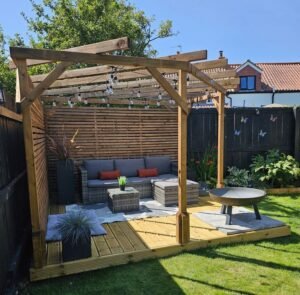
- 20 Covered Pergola Ideas to Keep You Cool and Stylish All Summer Long!
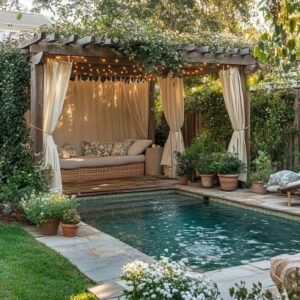
- 19 Cozy Deck Pergola Ideas for Your Ultimate Garden Retreat
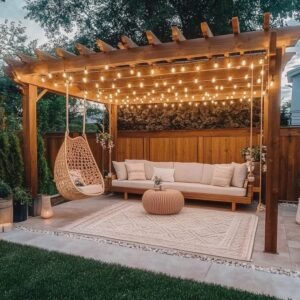
- 12 Low-Maintenance Small Perennial Garden Ideas for Busy Gardeners!
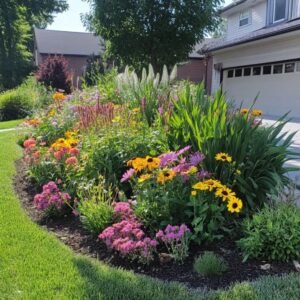
Geometric Mulch Patterns

Image Credit: seabiscuit16
Creating geometric patterns with mulch can add a modern twist to your landscaping.
By using different colors and textures, you can define spaces in your garden while enhancing visual interest. This method allows for creativity and personalization, making your front yard truly unique.
– Tip: Use edging materials to maintain clean lines and prevent mulch from spilling into unwanted areas.
– Insight: Mixing organic and inorganic materials can create a striking contrast.
– Unique Element: Incorporate small sculptures or garden art to enhance the geometric design.
This innovative approach to landscaping is not only visually appealing but also sustainable!
Mulch and Potpourri Mix

Image Credit: melaura
For a unique sensory experience, consider mixing mulch with dried flowers or potpourri.
This method adds scent and color to your garden, creating an inviting atmosphere. Perfect for walkways or around seating areas, this approach can turn your front yard into a fragrant retreat.
– Tip: Choose natural, organic materials to maintain eco-friendliness.
– Insight: This mix can also help deter pests naturally.
– Unique Element: Experiment with different scents to create a multi-sensory experience in your garden.
This delightful combination not only enhances the aesthetic but also provides an aromatic ambiance!
Indoor Mulch Gardens

Image Credit: smercer8
Don’t limit your mulch creativity to outdoor spaces!
Indoor gardens can benefit greatly from organic mulch. Using coconut coir or pine bark can help retain moisture and provide nutrients to houseplants. This innovative approach brings the beauty of outdoor landscaping inside.
– Tip: Ensure proper drainage to prevent overwatering.
– Insight: Using colored mulch can enhance the aesthetic appeal of your indoor garden.
– Sustainability Note: Indoor plants improve air quality while reducing indoor pollution.
Create a lush indoor oasis that mirrors the beauty of outdoor landscapes!
Bring the outdoors in! A sprinkle of organic mulch in your indoor garden not only retains moisture but also elevates your space with vibrant beauty. 🌱✨
Functional Mulch in Sloped Gardens

Image Credit: sparklylillady
Sloped gardens can pose challenges, but using mulch effectively can help.
Applying a thick layer of mulch can prevent erosion, enhance moisture retention, and stabilize the soil on slopes. This method promotes healthy plant growth while maintaining the beauty of your landscape.
– Tip: Combine mulch with ground covers to further stabilize the soil.
– Insight: Consider using heavy-duty landscaping fabric underneath the mulch for better control.
– Sustainability Note: This practice helps to maintain water quality by reducing runoff.
Transform your sloped yard into a functional and attractive space!
Creative Use of Recycled Materials

Image Credit: chrissyfletch
Get creative by using recycled materials as mulch alternatives in your garden.
This could include shredded cardboard, newspaper, or even old wood chips. Not only does this help the environment, but it can also give your garden a unique character.
– Tip: Ensure that recycled materials are free from chemicals or harmful substances.
– Insight: Shredded materials break down over time, enriching the soil naturally.
– Unique Element: Layering different materials can create a visually interesting texture in your garden.
This eco-friendly approach promotes sustainability while enhancing the beauty of your outdoor space!
Transform your garden with recycled treasures! 🌿 Using materials like cardboard or old wood chips not only nurtures your plants but gives your yard a unique, eco-friendly charm.
Frequently Asked Questions
Q: What Are Some Eco-Friendly Mulch Options for My Front Yard?
A: There are plenty of eco-friendly mulch options to consider for your front yard! You can use organic materials like shredded bark, wood chips, straw, or even leaves. These materials not only enrich the soil but also break down over time, providing essential nutrients to your plants.
Additionally, consider using recycled materials like shredded cardboard or old newspapers. They can serve as excellent mulch alternatives while helping the environment!
Q: How Does Mulch Landscaping Contribute to Sustainability?
A: Mulch landscaping is a fantastic way to promote sustainability in your garden! By using mulch, you help retain moisture in the soil, reducing the need for frequent watering. It also suppresses weeds, meaning less herbicide use, and provides a natural habitat for beneficial organisms.
Moreover, organic mulch breaks down over time, enriching the soil and supporting healthy plant growth, making your garden not just beautiful but also eco-friendly!
Q: Can I Use Mulch for Edible Plants in My Garden?
A: Absolutely! Using mulch around edible plants is a brilliant idea. It helps maintain soil moisture, suppress weeds, and can even provide some nutrients as it decomposes. Plus, it keeps your garden looking neat and tidy.
Just make sure to choose organic mulches, such as straw or grass clippings, to ensure your food remains healthy and safe to eat.
Q: What Are Some Creative Ways to Use Mulch in Landscaping?
A: Get ready to unleash your creativity with mulch! You can create geometric patterns in your garden, combine it with pavers for defined pathways, or layer it with stones for texture. Mixing colored mulches can add visual interest, and using white pebbles as accents can create a stunning contrast.
The possibilities are endless, so don’t be afraid to play around with different styles and materials to make your front yard truly unique!
Q: How Do I Choose the Right Mulch for My Garden?
A: Choosing the right mulch for your garden depends on a few factors. First, consider the plants you have and their specific needs. For instance, if you have moisture-loving plants, opt for a mulch that retains moisture well, like bark or straw.
Also think about the aesthetic you want to achieve. Dark mulches can make bright flowers pop, while lighter options can give a more subdued, elegant look. Finally, always prioritize eco-friendly materials to keep your landscaping sustainable!
Conclusion
Incorporating eco-friendly mulch landscaping ideas into your front yard is a fabulous way to express creativity while being kind to the environment.
From natural materials to vibrant flower beds, each idea brings beauty and sustainability together.
Which of these eco-friendly trends will you try in your garden? Let us know your thoughts and experiences!


